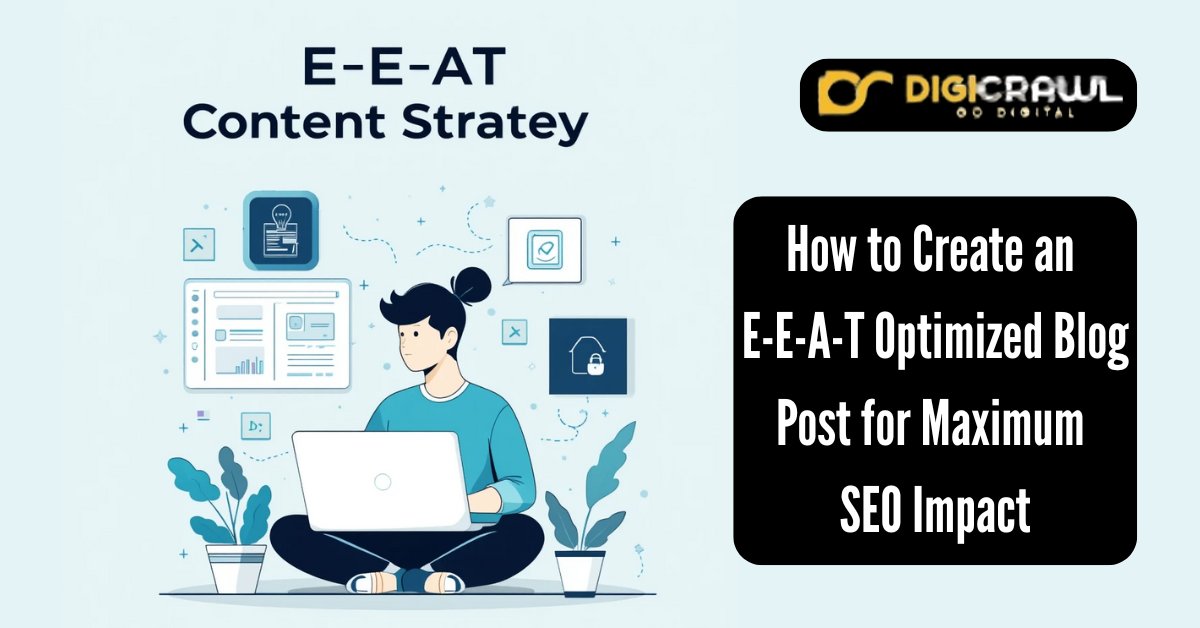How to Create an E-E-A-T Optimized Blog Post for Maximum SEO Impact
In the ever-changing algorithm of Google, one concept continues to stand out: E-E-A-T, which stands for Experience, Expertise, Authoritativeness and Trustworthiness. It’s a proven framework that can give your content an edge in this competitive blogging market. Additionally, it’s a core part of how Google decides whether your content deserves to rank or not.
If you’re a content creator, SEO professional or small business owner trying to make your blog content perform better in search results, understanding and applying E-E-A-T is essential.
Google’s search algorithm is constantly refining its search quality. In its Search Quality Raters Guidelines, Google emphasizes content that reflects real experience, solid expertise and trust signals from credible authors and sources.
This blog will walk you through how to create an E-E-A-T optimized blog post step-by-step, from research and structure to writing and on-page SEO.
What This Blog Will Cover
In this guide, you’ll learn:
- Why E-E-A-T matters for SEO in 2025 and beyond
- How to plan your blog content with intent and credibility in mind
- How to structure and format your posts for clarity and trust
- How to write content that demonstrates experience and authority
- What on-page SEO practices complement E-E-A-T principles
- Tools and tactics for strengthening your content’s E-E-A-T signals
1. Why E-E-A-T Is Important in Modern SEO
E-E-A-T isn’t a direct ranking factor like page speed or keyword usage, but it influences how Google’s algorithm calculates content quality, especially for YMYL (Your Money or Your Life) topics, which include think health, finance or legal content.
Even if your blog isn’t in a YMYL niche, demonstrating real-world experience, proven expertise and clear trust signals makes your content more helpful, reliable and rank-worthy.
For Example: A blog post about skincare written by a licensed dermatologist will likely be rated higher than a generic article with no credentials or author transparency.
By optimizing your blog posts for E-E-A-T, you signal to Google that your content is:
- Created by someone who’s qualified
- Based on real-world knowledge and experience
- Cited from credible sources
- Transparent about its authorship
2. Pre-Writing Stage: Prepare Your Blog for E-E-A-T Success
Identify Your Audience Intent
Start with: What does your reader want? Are they looking for information, a solution, a comparison or simply a product?
Use tools like:
- AnswerThePublic
- Google’s “People Also Ask” section
- Google Search Console’s performance data
Matching search intent is the foundation of building trust and authority.
Keyword Research (with E-E-A-T in Mind)
Pick keywords that align with your area of expertise. Use:
- Ahrefs or Semrush for keyword difficulty and volume
- Look for long-tail queries where you can provide real insights
Don’t target a keyword just because it has high volume; instead, choose topics where you can genuinely offer experience and value.
SERP Analysis
Study what’s already ranking for your target keyword:
- Are top results guides, opinions or case studies?
- Do those blogs feature authors, references or original research?
This helps you identify content gaps and what’s required to compete with top results.
3. Structuring Your Blog for Readability and SEO
A good structure doesn’t just help humans but also helps search engines understand the topical hierarchy of your post.
Use Clear Heading Hierarchies
- H1 for the main blog title
- H2s for main sections
- H3s for subpoints
Add a Table of Contents (TOC)
It improves navigation and signals organization. And thankfully, most SEO plugins (like Yoast or RankMath) allow you to insert this easily.
Use Short Paragraphs and Bullet Points
Keep your post digestible. Aim for:
- Paragraphs no longer than 3-4 lines
- Plenty of white space
- In addition, pull quotes or summary boxes
4. Writing Content with E-E-A-T in Focus
Here’s where you bring experience and expertise to life.
Demonstrate First-Hand Experience
- Share real examples, workflows or stories
- Add original photos and screenshots
- Use phrases like “In our experience…” or “Here’s how we handled…”
This is your edge against AI-generated or generic content.
Highlight Your Expertise
- Mention certifications, years of practice or past clients to develop trust and demonstrate your expertise.
- Moreover, link to your About page or previous work
Example:
“With over 8 years of helping eCommerce businesses grow their organic traffic, I’ve learned that…”
Show Authority with Supporting Content
- Quote industry experts
- Link to studies, white papers and Google’s documentation
Example:
According to Google’s official blog on helpful content, experience is a core component of content quality.
Build Trust Through Transparency
- Add an author bio at the end
- Show publish and update dates
- Link to privacy policy and contact page
5. On-Page SEO Best Practices for E-E-A-T Support
Even the best content can underperform without solid SEO basics.
Use Keywords Strategically
Include your target keyword in:
- The H1
- First 100 words
- URL
- Meta Title + Description
- A few H2s
Use Internal and External Links
- Link to relevant internal pages (services, related blogs, About and Contact)
- Link to high-authority sources (Google, Search Engine Journal and industry leaders)
Keep Content Fresh
Update blogs regularly with:
- New statistics
- Fresh insights
- Updated screenshots or links
Tool Tip: Use Yoast SEO or RankMath to ensure on-page SEO elements are optimized.
6. Enhancing Credibility Through Trust Signals
Want to go the extra mile? Add these trust-boosting elements.
Share Original Insights
- Conduct mini-surveys or original analysis
- Share before/after results or client stories (with permission)
Use Testimonials or Client Quotes
Add a quote or review related to the topic or service, if applicable.
Include Author and Site Credentials
- Use a real headshot
- Add links to author’s LinkedIn, Twitter or credentials
- Mention organizational affiliations or awards
Secure Your Site (SSL and Policies)
- Use HTTPS
- Have a visible Privacy Policy, Terms of Use and Contact info.
These small details go a long way in building trust with both Google and users.
7. Recommended Tools for E-E-A-T Optimization
Google Quality Rater Guidelines
Use this to understand how Google defines and evaluates E-E-A-T across different types of content.
These plugins help you optimize on-page SEO elements and improve content readability.
Powerful tools for keyword research, SERP analysis and understanding what’s ranking and on which topic you should write a blog.
Enhances your writing by checking for clarity, tone, grammar and engagement, all of which are important for trust and professionalism.
Detects AI-generated content and checks for plagiarism, helping ensure your content is both authentic and original.
Conclusion
In today’s SEO, high-ranking content must do more than just target keywords; it must prove its value, credibility and authenticity. By focusing on E-E-A-T, your blog not only becomes more helpful to readers but also more favorable in Google’s eyes.
Don’t wait until you are able to implement all of the above practices, start by applying one or two of the steps above to your next blog post. Over time, the cumulative effect of E-E-A-T optimization will lead to stronger rankings, deeper engagement and more authority in your niche and also in the eyes of Google.
Key Takeaways
The following are the takeaways of this blog;
- E-E-A-T reflects Google’s quality expectations for trustworthy and helpful content.
- Start by aligning your content with searcher intent and keywords you’re qualified to write about.
- Structure and format your blog post for both readability and SEO.
- Write with real experience, credible sources and make the author visible.
- Support E-E-A-T with internal links, trust pages and external validations.
- Use tools like Yoast, SEMRush and Google’s own guidelines to guide your process.
As a digital marketing agency committed to helping businesses grow online, DigiCrawl specializes in crafting E-E-A-T-optimized content strategies tailored for visibility and trust. If you’re looking for professional Digital Marketing services in Islamabad or need expert-level SEO Services in Pakistan, our team is here to support your growth with results-driven solutions.







